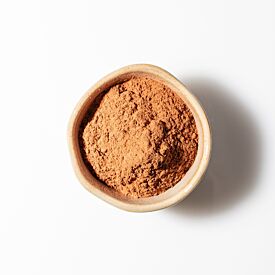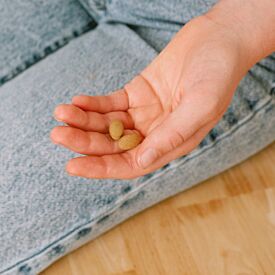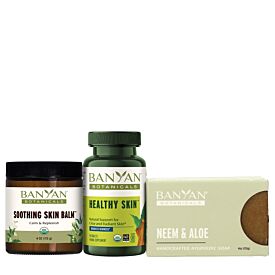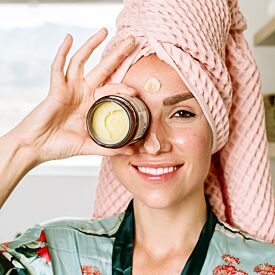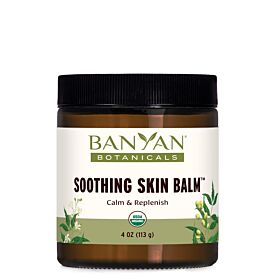Seasonal Skincare Rituals for the Fall Transition
Fall is known as the season of transition and change. Everything from the color of the trees, the weather, our diets, and even our beauty and skincare routines all undergo a natural shift toward a focus on warmth and relaxation. We need this time to transition from the extreme heat of summer to the chilly winter months.
As a unique life-science, Ayurveda honors the changing seasons with the practice of rtucharya, or a seasonal routine. This concept offers each individual the keys of knowledge which will unlock rasayana—the rejuvenation, strength, and energy to lead a long life of health and happiness.
Rtucharya can be applied to several aspects of our life, including our beauty and skin care routine. And let’s face it. When we feel cosmic, we look cosmic—and who doesn’t want to glow with that radiant feeling of happiness and wellness?
Ayurveda teaches us that our health (and beauty!) begins with knowing the divine root of our existence and all of the elemental factors which make up our personalities and physical attributes.
You might already be familiar with the doshas, the trio of energies which govern all functions of the body, described as a vata, pitta, and kapha. While each of us are fundamentally composed of all three, there is usually one dosha which best describes our prakriti, or the unique physical and metaphysical traits and tendencies we are born with. If you are curious about your prakriti, take a moment to take our Dosha Quiz!
Ayurveda encourages us to trust our intuition when it comes to our own idiosyncrasies, which is especially important when it comes to skincare. What we know about our prakriti has everything to do with the type of skin we have and the imbalances which can affect us—which is key when it comes to creating a seasonal skincare routine.
Fall Skincare Routines
Everything has a season, but the important question is how do we transition between them? Incorporating seasonal adjustments into your life and daily routine will offer immense stabilizing and rejuvenating benefits during times of natural transition.
Let’s look at a few guidelines for your skin during what Ayurveda calls ritu sandhi—the transitional time between seasons. The following routines are designed to support your natural, luminous glow while maintaining balance and harmony in mind, body, and spirit throughout the transition of fall.
Vata Skin
Vata skin is classically described as being on the thinner side and having those beautiful undetectable pores and delicate smoothness. These are qualities which should be preserved! But, if this is you, there may also be a tendency to have dry and flaky skin.
Here’s why! The light and delicate traits belonging to vata-type skin can cause weakness to the lipid barrier. The lipid barrier is also known as the moisture barrier of the skin. When this barrier becomes disturbed, the skin weakens, and as a result, can appear to show early signs of aging and lack of luster. For vatas, this tends to be the main concern.
Lifestyle Adjustments
- Incorporating more lubricating foods like olive oil and ghee, both externally and into your diet will help the skin retain strength and buoyancy.
- You can also incorporate a yogic breathing technique like Nadi Shodhana. This pranayama offers a grounding, stress-reducing rhythm which will keep the mind calm, the spirit calmer, and the skin calm and graceful as a result.
Vata Skincare Rituals
- I recommend using a creamy cleanser daily, and a gentle exfoliator like powdered oats once per week to help keep the skin smooth.
- A soothing and hydrating mask can be made with the same powdered oats and Neem Oil for added moisture to the skin. Recipe follows!
- Follow with a balancing and soothing toner, then seal the skin with a moisturizer like Beauty Balm.
| Simple Oat and Neem Mask for Vata Skin |
|
Ingredients:
|
|
In a small bowl, slowly add boiling water to your powdered oats and stir slowly until it becomes paste-like. Warm the Neem Oil to a comfortable temperature, then add to the paste. Stir well. Test the temperature of your mask on the inner part of your wrist, then apply to clean skin. Allow your mask to sit for about 15 minutes. No need to wait for it to dry—when it becomes dry, it is inactive. You can use this mask up to three times a week! *To powder your oats, use a blender or food processor. |
Soothing Pitta Skin
Pitta skin is classically described as being soft, warm, and a bit rosy in complexion, with a medium thickness. This is a sensitive skin type which is prone to developing blemishes, redness, heat rashes, and dark discoloration. It is very important to protect the lipid barrier in the case of pitta imbalance so that these symptoms don’t cause damage to the integrity of the skin over time.
Lifestyle Adjustments
- Starting with diet, avoid hot and spicy foods as they tend to create heat and swelling in the body which will eventually show up on your skin.
- Try to avoid activities which are directly in the heat, favoring gentle exercise in the early mornings or evenings when it’s cool outside.
- Incorporating a yogic breathing technique into your routine will help to keep the skin relaxed and pacified. Enjoy some Sheetali Pranayama throughout the day to keep the body and mind calm and relaxed.
Pitta Skincare Rituals
- Start your daily skincare routine with the Radiant Skin Bundle. This group of products provides the ideal foundation to maintain calm, smooth skin during this season. Use the Neem Oil to cleanse your skin daily, and apply the Soothing Skin Balm for additional topical nourishment as needed.
- You can also incorporate a soothing toner such as a high-quality rose water.
- Taken internally, Triphala and Healthy Skin tablets (both in the Radiant Skin Bundle) are excellent for helping to maintain balance by clearing excess heat from the blood and removing ama from the body.
Invigorating Kapha Skin
Kapha skin is classically described as being thick, soft, and cool to the touch. This type of skin generally produces more collagen, giving the appearance of being ageless! But on the flip-side, this lustrous skin type can often experience an overproduction of skin cells and clogged pores, thanks to kapha’s dense, earthy qualities.
Larger pores and excessive moisture or sweat can also cause puffiness and water retention. For kapha-type skin, it is important to break up stagnation so that the srotas, or channels in the body, do not remain blocked and cause dullness. When kapha-type skin develops clogged pores, this can stretch the pores and block nutrients from nourishing the lipid barrier of the skin.
Lifestyle Adjustments
- One basic way to keep this skin type balanced during this transitional time is to prevent excess kapha stagnation by incorporating the Kapha Balancing Bundle into your routine.
- Also, be sure to avoid heavy foods like sugar, cheese, and fatty meats.
- Incorporating a yogic breathing technique into your routine will be helpful in opening up circulation and keeping your skin bright and energized. Enjoy a pranayama like Bhastrika to help increase the flow of prana in the body and keep your complexion glowing and healthy!
Kapha Skincare Rituals
- I generally recommend that kaphas use an oil cleanser like Refined Sesame Oil, and add a drop of aromatherapy oil, such as eucalyptus, myrrh, or sage. Using a high quality refined oil can help to break down and prevent the stubborn build up in the pores which lead to enlargement and blemishes. Add this ritual to your morning and evening routine to feel the awakening difference in your skin.
- Stay away from heavy or creamy moisturizers as they can cause an additional buildup of oily debris. Rather, use something like ¼ teaspoon of jojoba oil and add a tiny drop of clove. Apply this to damp skin and gently massage in an upward motion.
- Try making your own kapha-balancing toner by adding distilled water to a spray bottle, then add one drop of geranium, lemon oil, and clove essential oils. This toner will keep your skin invigorated throughout the day!
Other Ideas for Supporting Your Skin
These are just some very basic guidelines and recommendations for each doshic skin type to get you started. If possible, it’s always a great idea to schedule an appointment with an Ayurvedic practitioner or skincare specialist to develop a more detailed plan.
Our skin is a true reflection of our internal state—everything that we put into our bodies, the quality of our sleep, our emotions, and how we handle our daily stressors. This makes our daily and seasonal efforts vital in maintaining as much balance and harmony as possible. Getting to know your constitution is the first step towards synchronization and success, and from there, may your inner and outer radiance be boundless!




